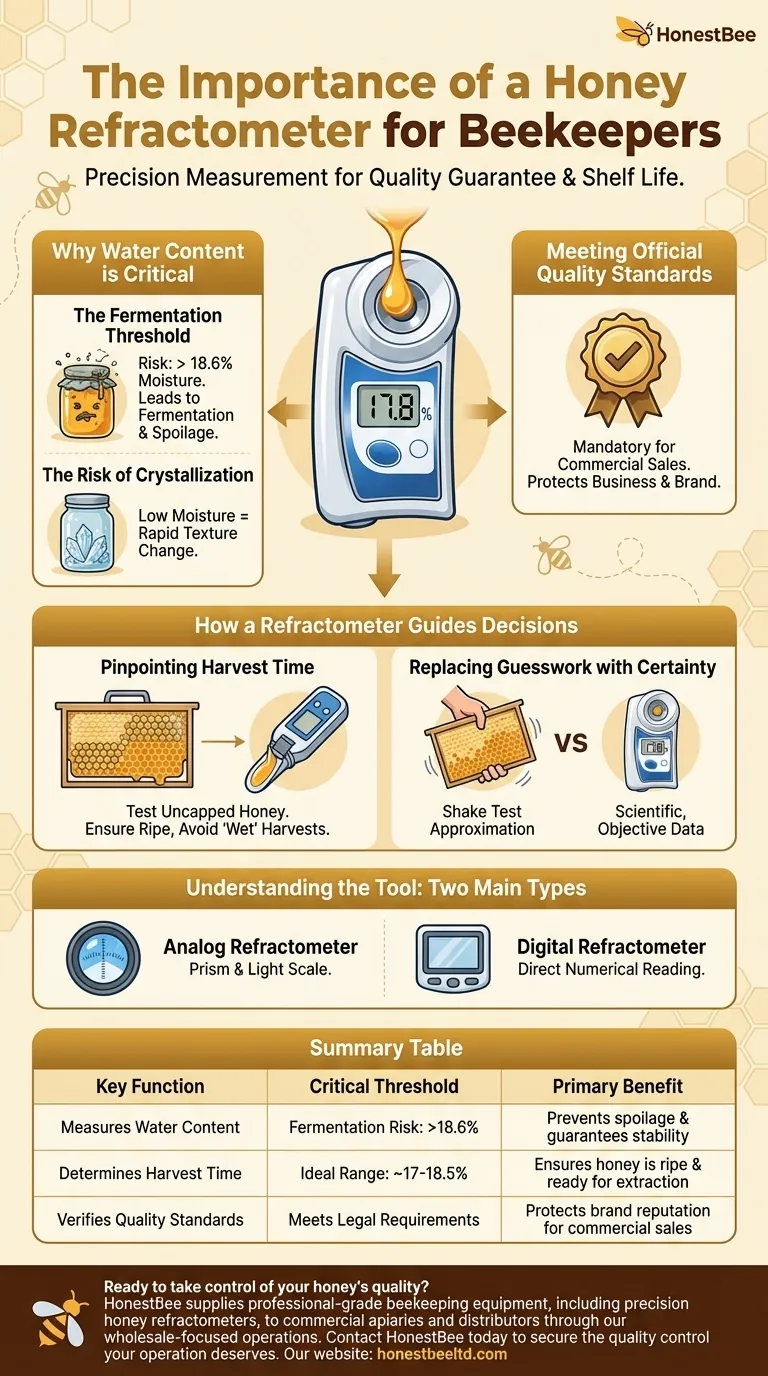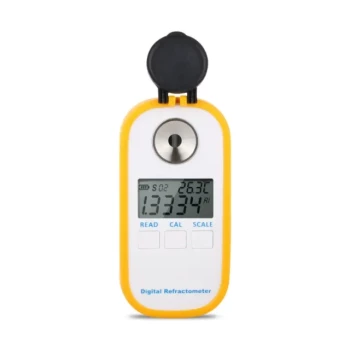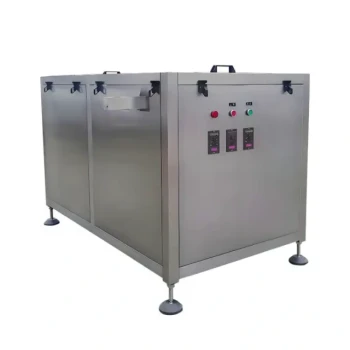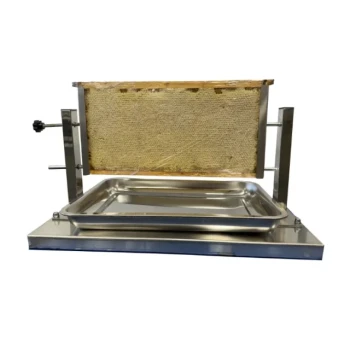The primary importance of a honey refractometer is to provide a precise measurement of the water content in honey. This single data point is the most reliable indicator of whether your honey will remain stable in storage or is at risk of fermenting, allowing a beekeeper to guarantee its quality and shelf life.
A honey refractometer transforms honey harvesting from an art based on guesswork into a science based on data. It is the definitive tool for ensuring your honey is ripe, stable, and meets the quality standards required for storage, sale, or personal use.

Why Water Content is the Critical Factor
The stability and quality of finished honey are almost entirely dependent on its moisture level. A refractometer is the only tool that can accurately measure this critical variable.
The Fermentation Threshold
Yeast spores are naturally present in honey. If the water content is too high—generally above 18.6%—these yeasts can become active and begin to ferment the sugars.
This fermentation process ruins the honey, giving it a fizzy texture and a sour, unpleasant taste. Honey with high moisture content is considered spoiled and cannot be sold or consumed.
The Risk of Crystallization
Conversely, honey with a very low water content is more prone to rapid crystallization. While crystallization is a natural process and does not indicate spoilage, controlling moisture levels can help manage its texture.
A refractometer gives you insight into how your honey is likely to behave in the jar, allowing you to manage customer expectations or processing steps.
Meeting Official Quality Standards
For commercial beekeepers, a refractometer is non-negotiable. Industry and legal standards mandate a specific maximum moisture content for honey to be sold to the public.
Using this tool ensures every batch meets these requirements, protecting your business, your brand, and the consumer.
How a Refractometer Guides Your Decisions
Beyond simple quality control, a refractometer provides actionable data that informs key moments in the beekeeping process.
Pinpointing the Perfect Harvest Time
Bees cap honey cells with wax once they have fanned the nectar to reduce its moisture content to the correct level. However, this isn't always uniform across every frame.
A refractometer allows you to test a small sample of uncapped honey to verify if it is truly "ripe" and ready for extraction. This prevents the costly mistake of harvesting an entire super of honey that is too "wet" and will spoil.
Replacing Guesswork with Certainty
Experienced beekeepers often use a "shake test"—turning a frame horizontally and giving it a sharp shake to see if nectar flies out. While useful, this is an approximation.
A refractometer provides a scientific, objective reading. This removes all doubt and ensures that your honey will remain stable and delicious for years to come.
Understanding the Tool
While scientifically precise, honey refractometers are simple to operate and designed for field use.
The Two Main Types
Beekeepers typically choose between two types of refractometers.
Analog refractometers are the most common. A drop of honey is placed on a prism, a cover is closed, and you look through an eyepiece towards a light source to read the moisture level on an internal scale.
Digital refractometers offer greater ease of use. A drop of honey is placed in a small well, a button is pressed, and the device provides a direct numerical reading of the moisture content on a screen.
Making the Right Choice for Your Goal
Ultimately, the decision to invest in a refractometer depends on the scale and goal of your beekeeping operation.
- If your primary focus is commercial sales: A refractometer is an essential, mandatory tool for quality control, meeting legal standards, and protecting your reputation.
- If your primary focus is serious hobby beekeeping: This tool is a highly valuable investment to guarantee the quality and long-term shelf life of every jar you produce.
- If your primary focus is just starting out: While not your first purchase, a refractometer becomes a critical tool the moment you plan to harvest and store honey.
Using a refractometer empowers you to take full control over the quality and integrity of your final product.
Summary Table:
| Key Function | Critical Threshold | Primary Benefit |
|---|---|---|
| Measures Water Content | Fermentation Risk: >18.6% | Prevents spoilage and guarantees stability |
| Determines Harvest Time | Ideal Range: ~17-18.5% | Ensures honey is ripe and ready for extraction |
| Verifies Quality Standards | Meets Legal Requirements | Protects brand reputation for commercial sales |
Ready to take control of your honey's quality?
As a beekeeper, you invest significant time and resources into producing a premium product. Don't leave its stability to chance. A reliable honey refractometer is the definitive tool for commercial apiaries and distributors to ensure every batch meets the highest standards, protects your brand, and satisfies your customers.
HONESTBEE supplies professional-grade beekeeping equipment, including precision honey refractometers, to commercial apiaries and distributors through our wholesale-focused operations. We provide the tools you need for success.
Contact HONESTBEE today to discuss your equipment needs and secure the quality control your operation deserves.
Visual Guide

Related Products
- Precision Honey Refractometer Instrument for Quality Assessment
- Digital Honey Refractometer for Precision Measurement of Optimal Honey Quality
- Professional Thermostatic Conical Honey Melter
- Honey Concentrating Vacuum Heating Thickening Machine Dehumidifier for Honey
- HONESTBEE 3-Frame Manual Acrylic Honey Extractor
People Also Ask
- What is a honey refractometer? The Essential Tool for Perfect Honey Quality
- What are the benefits of using a Pocket Digital Honey Refractometer? Achieve Precision & Speed in Honey Quality Control
- Why is a honey refractometer essential for honey harvesting? Protect Your Harvest from Spoilage
- What are the key steps to using a honey refractometer? Ensure Honey Quality & Prevent Fermentation
- Why is a honey refractometer considered essential for commercial beekeepers? Ensure Honey Quality and Profitability



















